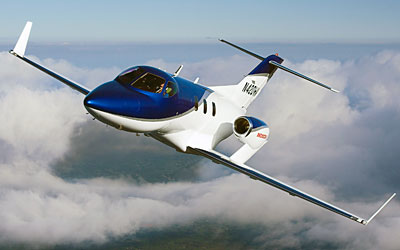
Featuring a number of innovations including a patented over-the-wing engine-mount configuration, a natural-laminar flow (NLF) wing and fuselage nose, and an advanced all-composite fuselage structure, the experimental Honda Jet is an advanced, lightweight, compact business jet that features far better fuel efficiency, more available space in the fuselage, and higher cruise speed than conventional aircraft in its class. The Honda Jet is powered by two Honda HF-118 engines, each rated at 1,670-pound thrust at takeoff power.
"This public world debut of the Honda Jet represents the continued advancement of Honda's long-standing dream of aviation," said Michimasa Fujino of Honda. "We are pleased and excited to be able to share this dream and our technology with the aviation community."
The result of nineteen years of research on small aircraft, Honda Jet includes a series of innovations. The wing and fuselage nose were developed through extensive analyses and wind-tunnel testing.
Honda Jet's patented over-the-wing engine-mount configuration helps eliminate the need for a structure to mount the engines to the rear fuselage and, thus, maximizes the space in the fuselage. Further, by determining the optimal position for the engines, the over-the-wing mount actually reduces drag at high speed to improve fuel efficiency.
The advanced all-composite fuselage structure consists of a combination of honeycomb sandwich structure and co-cured stiffened panels. It was developed to reduce weight and manufacturing costs. This experimental aircraft is also outfitted with a state-of-the-art glass cockpit with an integrated avionics system, as well as an autopilot function.
Honda produces 19 million engines a year.